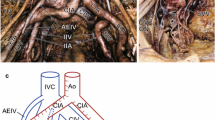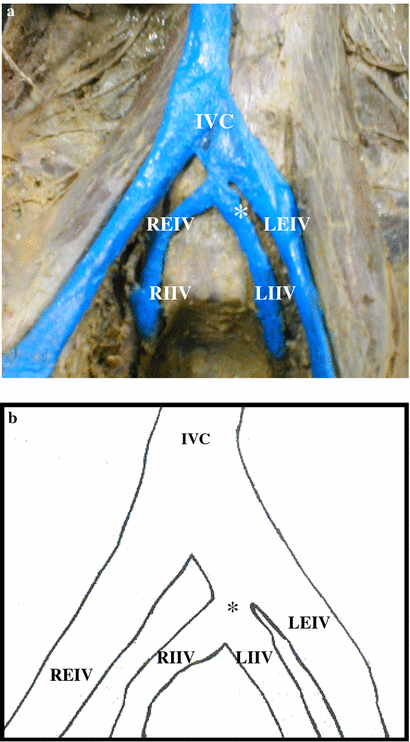Abstract
During regular dissection of the retroperitoneal region, three uncommon anatomical variations of the internal iliac veins were found on dissected specimens: in the first case, the internal iliac veins converge forming a common trunk draining into the left external iliac vein. In the other two cases, the internal iliac vein crosses the median plane and flows into the contralateral common iliac vein. These anomalies result from a persistence of the embryonic inferior branch of the cardinal vein and are important to be known for they may be undetected or may not appear in imaging. These data have implications for both pelvic surgeons and anatomists who manipulated this anatomical area.
Similar content being viewed by others
Explore related subjects
Discover the latest articles, news and stories from top researchers in related subjects.Avoid common mistakes on your manuscript.
Introduction
The common iliac veins are formed by the junction of the internal and external iliac veins. The internal iliac veins ascend from the pelvis with various tributaries that correspond to the branches of the internal iliac artery, while the external iliac veins are the upward continuation of the femoral veins [10].
The position of the iliac veins is described according to the corresponding arteries and the variations of the iliac veins and their relationships can be important in retroperitoneal surgical interventions such as the superior hypogastric neurectomy and hysterectomy as well as in the interpretation of the pelvic imaging, particularly in the computed tomography (CT) scanning or in the magnetic resonance [5, 9].
The anatomical variations and the congenital anomalies of the iliac veins were well described [4]. Among the numerous variations of these veins, the right and the left internal iliac veins usually drain towards the contralateral external iliac vein [4]. On the other hand, their junction and opening as a common trunk at the confluence of the right and the left external iliac veins to form the vena cava is much less known. In this paper we present three cases of rare variation in the course and affluence of the internal iliac vein discovered during the dissection of the retroperitoneal region.
Case report
During the dissection of the retroperitoneal region of three middle-aged black male cadavers kept in formaldehyde at 10%, a variant drainage pattern of the right and left internal iliac veins was found. It had a deviation in its normal course and an atypical affluence.
In case 1, both internal iliac veins join, thus forming a common trunk with a short and an average course, receiving the middle sacral vein’s drainage and flowing into the left external iliac vein (Fig. 1a, b). In case 2, the right internal iliac vein has a course that stretches cranially, crossing the median plane and flowing into the left common iliac vein that received the middle sacral vein’s drainage (Fig. 2a, b). In case 3, a symmetrical pattern was observed in relation to case 2; the left internal iliac vein received the middle sacral vein’s drainage and has a course that stretches cranially crossing the median plane and flowing into the right common iliac vein (Fig. 3a, b).
a Internal iliac veins join, thus forming a common trunk (*) with a short and an average course, draining into the left external iliac vein. IVC Inferior vena cava; REIV right external iliac vein; LEIV left external iliac vein; RIIV right internal iliac vein; LIIV left internal iliac vein. b Schematic drawing of case 1. IVC inferior vena cava; REIV right external iliac vein; LEIV left external iliac vein; RIIV right internal iliac vein; LIIV left internal iliac vein; (*) both internal iliac veins join forming a common trunk with a short and an average course, draining into the left external iliac vein
a Right internal iliac vein has a course that stretches cranially (+), crossing the median plane and flowing into the left common iliac vein. IVC Inferior vena cava; REIV right external iliac vein; LEIV left external iliac vein; RIIV right internal iliac vein; LIIV left internal iliac vein; LCIV left common iliac vein. b Schematic drawing of case 2. IVC Inferior vena cava; REIV right external iliac vein; LEIV left external iliac vein; RIIV right internal iliac vein; LIIV left internal iliac vein; LCIV left common iliac vein; +: right internal iliac vein has a course that stretches cranially, crossing the median plane and flowing into the left common iliac vein
a Internal left iliac vein has a course that stretches cranially crossing the median plane and flowing into the right common iliac vein (Plus Circle). IVC Inferior vena cava; REIV right external iliac vein; LEIV left external iliac vein; RIIV right internal iliac vein; LIIV left internal iliac vein; RCIV right common iliac vein. b Schematic drawing of case 3. IVC inferior vena cava; REIV right external iliac vein; LEIV left external iliac vein; RIIV right internal iliac vein; LIIV left internal iliac vein; RCIV right common iliac vein (Plus Circle) left internal iliac vein has a course that stretches cranially crossing the median plane and flowing into the right common iliac vein
The internal iliac vein’s origin resulted bilaterally from an anterior branch receiving the visceral drainage (vesical, prostatic and rectal veins) and a posterior one receiving the parietal drainage (gluteal and lateral sacral veins); with the obturator veins draining directly into the internal iliac veins. While the external iliac veins origin bilaterally from the femoral veins.
In all cases, the abdominal aorta divides into the two common iliac arteries; each passed downward and lateralward and divided into two branches, the external (supplying the lower extremity) and the internal (supplying the viscera and pelvic wall) iliac arteries. As they were normal in division and location, they were removed to give more emphasis to the veins.
Discussion
The iliac veins result from a complex embryonic process of formation and an embryological point of view can easily explain the variations of the retroperitoneal venous system. The retroperitoneal venous system is derived from the modification of three parallel sets of veins—the subcardinal, the postcardinal and the supracardinal veins—between the sixth and the tenth weeks of gestation [4].
The inferior vena cava function is initially carried out by the right and the left postcardinal veins, which receive the venous drainage of the lower limb buds and pelvis, receiving tributaries from the body wall and from the derivatives of the mesonephroi. The subcardinal veins become connected to the postcardinal veins by a number of vessels traversing the medial part of the ridges. The subcardinal veins intercommunicate by a pre-aortic anastomotic plexus, which later constitutes the part of the left renal vein crossing anterior to the abdominal aorta. The formation of an oblique transverse anastomosis between the iliac veins—which itself becomes the major part of the definitive left common iliac vein—diverts an increasing volume of blood into the right longitudinal veins, accounting for the ultimate disappearance of most of those on the left. The enlargement of the metanephros diverts the postcardinal vein from its course and the venous drainage of the mesonephric ridge is assumed by the subcardinal vein. At the same time new longitudinal channels appear and take over intersegmental venous drainage, and the whole of the postcardinal vein disappears. The only adult derivatives of the postcardinal veins are the root of the azygos vein, the iliac bifurcation and the iliac veins [2, 8, 10].
We present three cases of rare variation in the course and affluence of the internal iliac vein discovered during the dissection of the retroperitoneal region. These anomalies result from a persistence of the embryonic inferior branch of the cardinal vein and are important to be known for they may be undetected or may not appear in imaging.
The ability to recognize and manage venous anomalies is essential. The knowledge of these variations is important in pelvic surgeries in which the dissection of these vessels and the knowledge of their course will be taken into account in the profilaxy of the vascular lesions or in the interpretation of the pelvic imaging, the CT scanning or in the magnetic resonance [1, 9]. The number of surgical procedures and radiological examinations related to the retroperitoneum are increasing and therefore, venous variations of the retroperitoneal area are being more frequently discussed [2, 3, 8].
The internal and the external iliac veins are frequently manipulated by interventions on the pelvis such as the retroperitoneal lymphadenectomies, anastomosis during a kidney transplant, hypogastric neurectomy and hysterectomy. The case of the internal iliac vein and its affluents, a systematic search for any possible anomalies of the retroperitoneal veins is needed. Particularly in lymphadenectomy, the complexity of the anomalies of the internal iliac vein may modify the technical possibilities of the surgical procedure. In hysterectomy, surgical interference on these veins may seriously affect venous drainage and precipitate an edema on one or both legs [5, 10]. In orthopedic surgery, the internal iliac vein was most at risk for injuries during operations involving screw placement [6]. The anatomical knowledge of the internal veins and its variations is of extreme importance for the surgeon who deals with the retroperitoneal and pelvic regions mainly due to the current frequency of the renal transplant surgeries.
Tomography, especially with the latest developments in multislice CT technology, is definitely well suited to describe the normal anatomy and its variations as well as pathologies [1, 8]. Studies have reported that the CT is a reliable diagnosis method of venous thrombosis and it is preferable to venography, being suitable for the evaluation of the vascular injuries that occurred during laparoscopy [1, 7]. These three types of anomalies of the internal iliac veins may represent real traps in the interpretation of pelvic imaging, particularly in CT scanning, where they are not always recognized, or in the magnetic resonance imaging. They may be the source of technical difficulties in the diagnostic or therapeutic angiography and may modify the values obtained by the retroperitoneal surgery.
The anatomical variations of the pelvic vessels constitute congenital morphologic differences observed in the human body. Although most of them do not cause functional damage, they can be relevant during surgical procedures. This anatomical curiosity should be kept in mind by clinicians, pelvic surgeons and anatomists who are to manipulate this anatomical area.
References
Allgayer B, Reiser M, Ries G, Feuerbach S (1981) Computed tomographic demonstration of venous thrombosis of different etiologies. Eur J Radiol 1:204–206
Babaian RJ, Johnson DE (1979) Major venous anomalies complicating retroperitoneal surgery. Southern Med J 72:1254–1258
Baldridge ED Jr, Canos AJ (1987) Venous anomalies encountered in aortoiliac surgery. Arch Surg 122:1184–1188
Bergman RA, Thompson SA, Afifi AK, Saadeh FA (1988) Compendium of Human Anatomic Variation. Urban & Schwarzenberg, Baltimore
Edwards WR (1996) Hysterectomy, massive transfusion and packing to control haemorrhage from pelvic veins in the course of bilateral oophorectomy. Aust N Z J Obstet Gynaecol 36:82–84
Keating EM, Ritter MA, Faris PM (1990) Structures at risk from medially placed acetabular screws. J Bone Joint Surg Am 72:509–511
Nezhat C, Childers J, Nezhat F, Nezhat CH, Seidman DS (1997) Major retroperitoneal vascular injury during laparoscopic surgery. Hum Reprod Mar 12:480–483
Sürücü HS, Erbil KM, Tastan C¸ Yener N (2001) Anomalous veins of the retroperitoneum: clinical considerations. Surg Radiol Anat 23:443–445
Tanagho EA, McAninch JW, Smith MD (2000) General Urology, 15th edn. McGraw-Hill, New York
Williams PL, Bannister LH, Berry MM, Dyson M, Dussek JE, Ferguson MWJ (1995) Gray’s anatomy, 38th edn. Churchill-Livingstone, Edinburgh, pp 1598–1599
Author information
Authors and Affiliations
Corresponding author
Rights and permissions
About this article
Cite this article
Cardinot, T.M., Aragão, A.H.B.M., Babinski, M.A. et al. Rare variation in course and affluence of internal iliac vein due to its anatomical and surgical significance. Surg Radiol Anat 28, 422–425 (2006). https://doi.org/10.1007/s00276-006-0110-3
Received:
Accepted:
Published:
Issue Date:
DOI: https://doi.org/10.1007/s00276-006-0110-3







